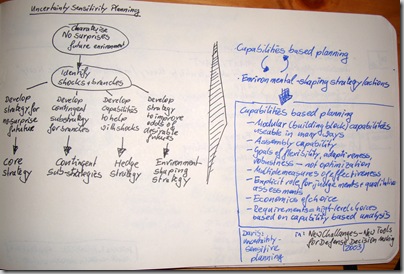Davis, Paul K.: Uncertainty Sensitivity Planning; in: Johnson, Stuart; Libicki, Martin; Treverton, Gregory F. (Eds.): New Challenges – New Tools for Defense Decision Making, 2003, pp. 131-155; ISBN 0-8330-3289-5.
Who is better than planning for very complex environments than the military? On projects we set-up war rooms, we draw mind maps which look like tactical attack plans, and sometimes we use a very militaristic language. So what’s more obvious than a short Internet search on planning and military.
Davis describes a new planning method – Uncertainty Sensitivity Planning. Traditional planning characterises a no surprises future environment – much like the planning we usually do. The next step is to identify shocks and branches. Thus creating four different strategies
- Core Strategy = Develop a strategy for no-surprises future
- Contingent Sub-Strategies = Develop contingent sub-strategies for all branches of the project
- Hedge Strategy = Develop capabilities to help with shocks
- Environmental Shaping Strategy = Develop strategy to improve odds of desirable futures
Uncertainty Sensitivity Planning combines capabilities based planning with environmental shaping strategy and actions.
Capabilities based planning plans along modular capabilities, i.e., building blocks which are usable in many different ways. On top of that an assembly capability to combine the building blocks needs to be planned for. The goal of planning is to create flexibility, adaptiveness, and robustness – it is not optimisation. Thus multiple measurements of effectiveness exist.
During planning there needs to be an explicit role for judgements and qualitative assessments. Economics of choice are explicitly accounted for.
Lastly, planning requirements are reflected in high-level choices, which are based on capability based analysis.

